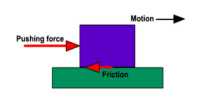There are five types of motion:
- Linear
- Rotational
- Rectilinear
- Periodic
- Vibratory
Linear motion: If a body is in motion along a straight line, that is, if the motion of a body is restricted on a straight line its motion is called linear motion. The motion of a car in a straight street is linear motion.
Rotational motion: When a body rotates around a particular point or an axis keeping the distance of the particles of the body unchanged is called rotational motion. For example, motion of an electric fan, motion of the heads of a clock.
Rectilinear motion: When a body moves along a straight line in such a way that each particle of the body travels the same distance at the same time in the same direction. If a book is pushed to shift from one end to the other of a table without rotation, the motion will be rectilinear because all the particles of the book travel the equal distance, at equal time in the same direction.
Periodic motion: If the motion of a moving particle is such that it passes through a definite point along the path of its motion in the same direction in a definite interval of time, this type of motion is called periodic motion. This motion can be circular, elliptical or rectilinear. The motion of the hands of a clock, the motion of earth round the sun, the motion of piston in the cylinder of a steam or petrol engine etc. The time interval at which a particle of periodic motion passes through a definite point from the same direction repeatedly is called its time period.
Vibratory motion: If a body executing periodic motion moves in a definite direction for one half of its time period and exactly for the other half in the opposite direction then this motion is called vibratory motion. Motion of a simple pendulum, motion of vibrating tuning folic and the motion of string of guitar.












